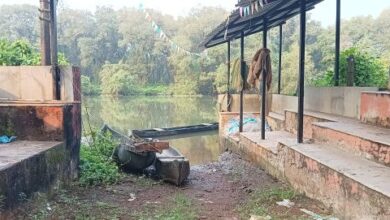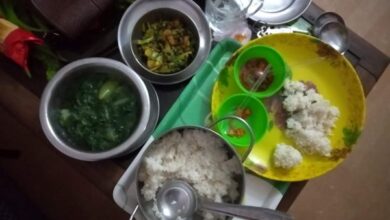A collage of narrations & emotions from Nagaland
The 2019 book published by Zubaan curates short stories, poems & illustrations that reflect on roots & identity

 A friend’s father, whose family migrated from erstwhile East Pakistan during the Liberation War and settled in a colony in south Calcutta (now Kolkata), once said in the context of displacement, “Though we accepted our fate in a new country, we never forgot our roots. It is this attachment that strengthens our identity and lessens the pain of the loss.”
A friend’s father, whose family migrated from erstwhile East Pakistan during the Liberation War and settled in a colony in south Calcutta (now Kolkata), once said in the context of displacement, “Though we accepted our fate in a new country, we never forgot our roots. It is this attachment that strengthens our identity and lessens the pain of the loss.”
This was more than three decades ago, when the words ‘roots’ and ‘identity’ barely meant anything to me. That changed over the decades. However, never have I felt the syntax of emotions in his words so deeply as I did while reading the collection of stories in Many That I Am: Writings from Nagaland.
Edited by Anungla Zoe Longkumer, the book is an emotional journey of individuals to their roots. Whether it is Mangyang’s longing for the land, Yarla’s tattoos, Otsula’s stories, Azao Temsu’s pottery or Loreni’s grit, every narration gives a distinct shape to the identity that has turned a palimpsest of changing times, both good and bad.
My land, my identity
In Where Hills Grow Houses by Emisenla Jamir, Mangyang, a retired government employee, desires to build a house in the place that he calls home. He nourishes this thought while revelling in the warmth of the first sun rays and the birds’ songs every morning. He worries about the hills “groan with the weight” of the mushrooming concrete. The onslaught of time may deface his beloved land, but he belongs there. So, he turns violent when he loses the last ray of hope.
While Mangyang tries to hold on to his “sunlight” in vain, modernity gradually erases the tribal identity. The tradition of tattooing that sisters Noksangmengla and Yarla started is now extinct and exists only in Grandmother’s tales. Sirawon Tulisen Khating finds inspiration in these tales and takes pride in her identity as an Ao-Naga (Retold by Grandma — Yarla’s Tattoos).
The new generation must be told the stories of its ancestors, so the youth are rooted in history and aware of their identity. But who will tell the stories after Grandma? Where are the storytellers like Otsula today? Does anyone even want to be a storyteller?
The protagonist in Emisenla Jamir’s second short story (Storyteller) in the collection talks about this vanishing tradition. She pines to be a storyteller like Otsula, who assiduously crafts her words to mesmerise her listeners. She wants to discover the ancestral treasures and take forward the legacy of oral history.
Dark history
The collection also has stories reminiscing about the chequered history of the land and the anguish of people. Two such stories are Cherry Blossoms in April by Easterine Kire and The Letter by Temsula Ao.
Kire’s story traces the history of World War II, when Japanese soldiers infiltrated Nagaland to dent the British supply lines. A love story bloomed in the time of war and Sanuo started a new life with a young Japanese soldier.
Cherry Blossoms is more than a love story. It portrays a time in history when the trauma of the war indirectly impacted lives in Nagaland, like it did Sanuo’s. The folktale narrated by Sanuo’s grandmother adds a surreal dimension to the love story.
Kire also mentions the beautiful tradition of two lovers agreeing to be partners with the consent of their relatives, friends and the entire village. Once common among tribal cultures in the North East and the rest of India, this practice of living together without the rigours of institutional marriage has been widely spurned post the advent of Christianity.
Time has not just changed the tribal ways of life, but it has had a debilitating impact on those who survived the violent days of insurgency and the State’s high-handedness. The Letter is the narration of such a time. One could stand his ground in the face of crisis and risk life, or one could become a part of the barbarism and be bruised for life.
Women’s voice
What stands out in the collection of stories is the strong voice of women, who play a crucial role as protectors of both individuality and collective identity.
One story that can shake the conscience of any woman is Avinuo Kire’s The Power to Forgive. Can forgiveness heal wounds which gangrene one’s body and soul? The protagonist struggles with her inner self to find the answer. For years, she lives with the trauma of rape and the anger against her father for forgiving the culprit.
When Dzuvinguno Dorothy Chasie writes, “Find me my parts and give them to me/I’ve lost my valuable parts./I have my hands, my arms, and my legs;/But something-/Something still feels like it’s missing,”, it resonates with Kire’s protagonist.
Probably, it is this angst in a patriarchal society that makes Abokali Jimomi say, I Wish You Were A Man, “we could have been best buddies,/going out drinking, thrashing out issues, talking politics”.
While these women’s voices cry out for freedom, they don’t lose the tune for the tribal identity and the homeland, because it is where “The womb that held/You is buried here inside our earth” (Odyssey by T. Keditsu).
Vocal illustrations
The book has a collection of illustrations which speak louder than words. A woman in traditional attire breaks the glass ceiling (Untitled by Marriane Murry), a woman feels her freedom despite the darkness and nakedness marking her body (Untitled by Limatola Longkumer), or a girl screaming out to the dystopian society that tries to chain her (Letting Go by Aniho Chishi) are among the illustrations with voices of their own.
A different perspective
Longkumer’s carefully curated stories from Nagaland — published by Zubaan in collaboration with Sasakawa Peace Foundation in Japan in 2019 — may be works of fiction, but these narrations give a different perspective to the changing face of the northeastern state. The women authors delve deep into the various aspects of life, including in contemporary times, in their homeland and create hues of emotions through lucid and compelling storytelling that will leave a mark on even those unaware of the history of the land and its tribes.
Book: The Many That I Am; Publisher: Zubaan: Edited by: Anungla Zoe Longkumer; Pages: 180; Price: Rs 495






